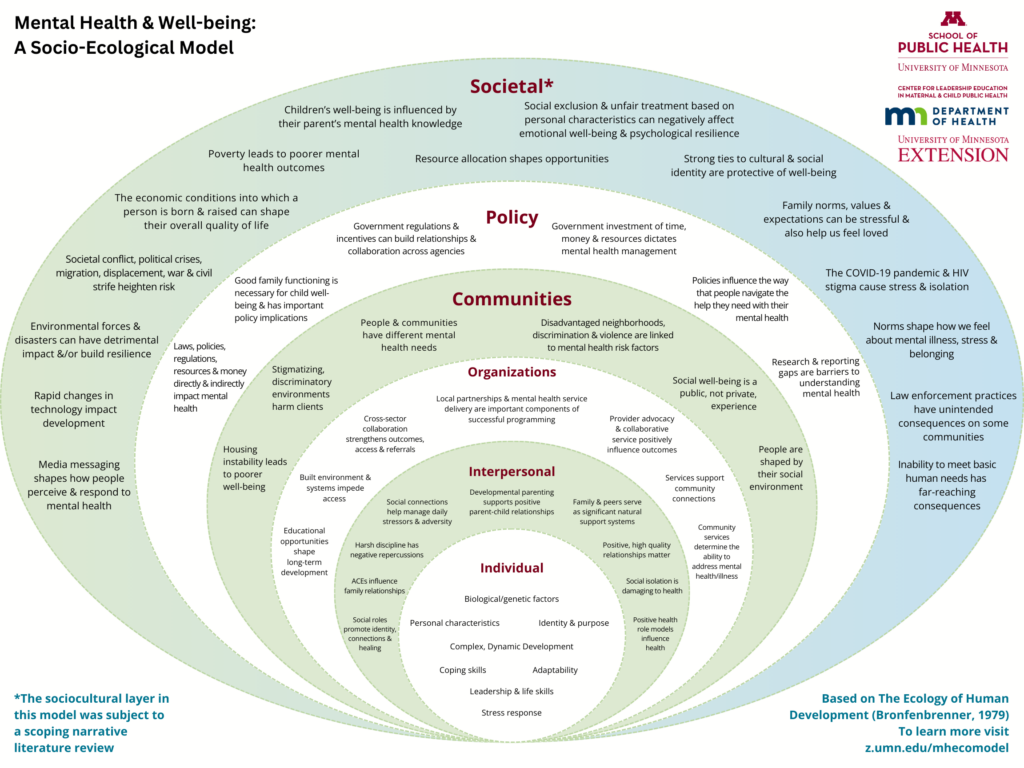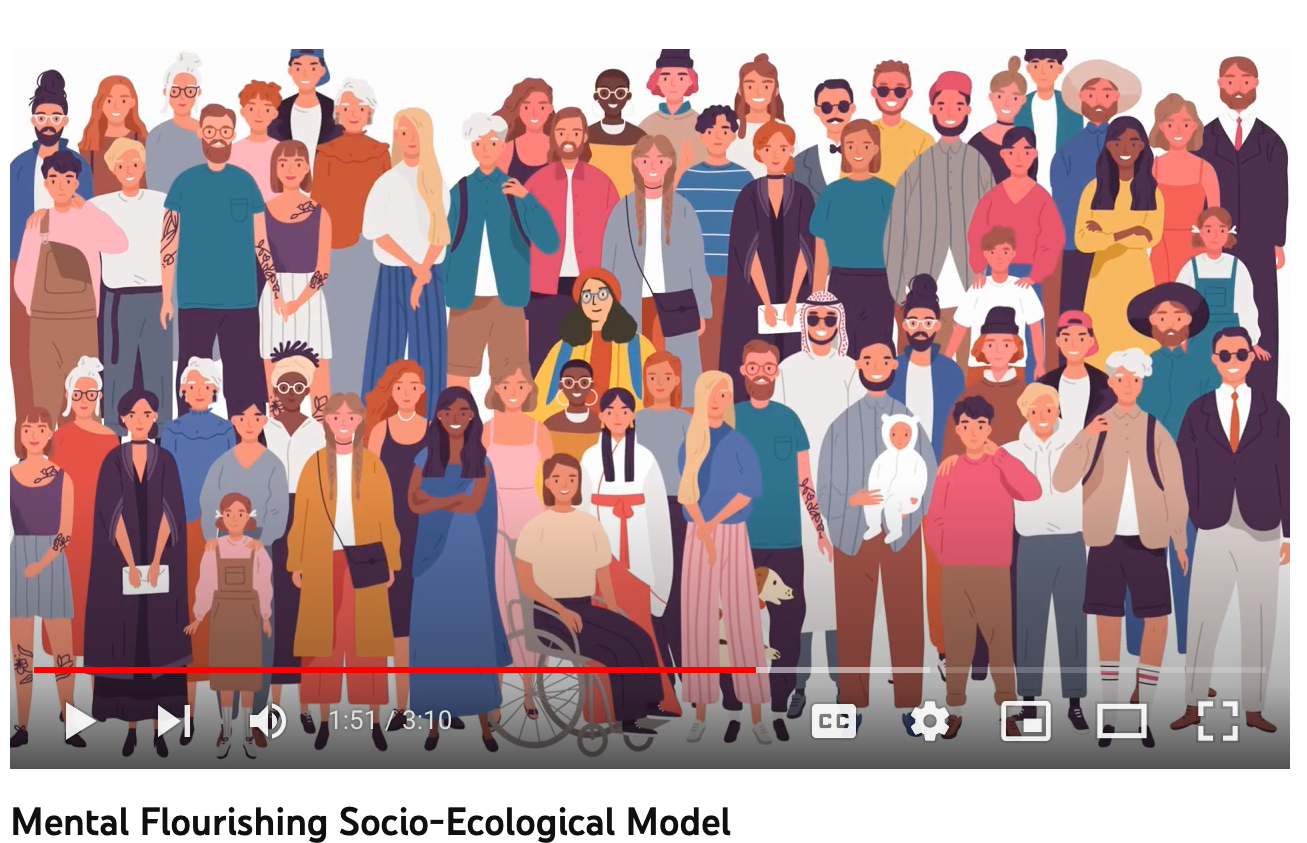
About this Model
Health has been described as “a state of complete physical, mental, and social well-being and not merely the absence of disease or infirmity” and defines mental health as “a state of mental well-being that enables people to cope with the stresses of life, realize their abilities, learn well and work well, and contribute to their community.”
The Socio-ecological Model (SEM) recognizes that individuals affect and are affected by a complex range of social influences and nested environmental interactions. In 2020, we illustrated a Mental Health and Well-being SEM to show that individual, family, organization, community and societal factors influence mental health and well-being. Our SEM considers the whole person and mental health across the lifespan. This public health approach to mental health helps all children and families thrive mentally, socially and emotionally, with and without diagnoses.
In summer 2024, we released an updated version of our Mental Health and Well-being SEM (PDF) to gather additional evidence for the societal level of the existing model.
What’s New in the Updated Model
This mental health and well-being SEM is always evolving, and its authors consider it a living document. The statements on the model address some of the “What?” (i.e., what are the influencing factors around mental health and well-being?), capturing existing research and leaving room for new findings and other ways of knowing (Rivera-Segarra et al., 2022).
Based on our extensive scoping narrative review, the updated SEM continues to expand conversations around mental health promotion, emphasizing how high-level social determinants operate through inner-layer contexts. It also offers communitarian public health action items informed by the literature, as we all have a part to play in supporting each other’s well-being.
Access the detailed report, Societal-level Determinants of Mental Health and Well-being: A Social-Ecological Model and Report.
How to Use this Model
How do we move from understanding the literature into taking action? You can start by asking:
- Where do I see myself, my work, or my organization in this model?
- To what level(s) of influence am I drawn?
- Where can I make the most impact, and where is collective effort required?
- How does this multilayered, multi-directional perspective of mental health and well-being inform my work?
Then, think about the statements below, or create your own. List some specific and actionable short, medium and long-term steps that you and/or your organization may take.
- Promote individual and family solutions to support mental well-being (e.g., self-efficacy)
- Learn and teach others to manage stress and cope with adversity
- Provide health education to support parent-child/caregiver-child relationships
- Promote social connections – between family, neighbors, employees, etc.
- Expand youth development in schools and out-of-school settings
- Increase skill-based learning to promote adaptability, coping and resilience
- Support local communities taking an active role in reducing isolation, meeting basic needs, and understanding/responding to the mental health needs of its members
- Increase collaboration between service organizations to strengthen service coverage, access and referral processes for a more integrative, comprehensive approach
- Increase natural and informal social support systems
- Address societal issues
- Coordinate mental health prevention efforts at the federal, state and local levels
- Explore and create prevention/promotion activities that strengthen flourishing for individuals and communities
- Fund mental health promotion research and community-based supports
- Balance resource allocation
The Mental Health and Well-Being SEM in Action
Our model (SEM) was featured in the article “Promoting Wellness for an Inclusive Perinatal Population: Strategies for Counselors” (Journal of Mental Health Counseling, 2023)! The authors used our SEM to “present risk and protective factors associated with perinatal mood and anxiety disorders and apply the socio-ecological model of mental health and well-being to demonstrate how counselors can use their own and their clients’ levels of influence to promote wellness.”
MCH alumnus Paige Erickson and current MCH student Ashlee Cermak presented the poster “A Socio-Ecological Model of Mental Health and Well-being: Societal Factors” at the Minnesota Public Health Association annual conference in April 2024.
We love seeing our model referenced elsewhere, especially in scholars’ dissertations and thesis papers. See several below. Congrats to the grads/authors!
- Relationships Harm, Relationships Heal: Exploring Larger Bodied People’s Experiences of Weight Stigma and Eating Disorders in the Context of Family Relationships
- A Mental Health Professional Opinion on Family Involvement During the Treatment of Severe Mental Illness: A Multiple Case Study
- Resilience in Girlhood: An Analysis of the Social Determinants of Anxiety Disorders for Adolescent Girls
Have you used or referenced our model? We’d be happy to reference it here! Email Sara at mch @ umn.edu with details.
Food for Thought
This SEM was created to help shift the narrative about mental health and mental illness from an individual issue to include the social and environmental responsibility of others (Biglan et. al., 2013).
This model also helps to shift the mental health narrative from one focused on illness to mental well-being, or flourishing (Keyes, 2014; Keyes 2002). The context that the SEM provides helps us consider that with proper support, people with mental health diagnoses can flourish– and people without diagnoses can languish, too. A focus on mental health promotion and primary public health prevention acknowledges the importance of supporting mental well-being for everyone.
We hope this SEM will reveal a bigger picture of well-being, and prompt a range of new strategies across mental and public health.
About the Socio-Ecological Model
The “socio-ecological model” (the Ecology of Human Development) was developed by Urie Bronfenbrenner in the late 1970s, as a way to recognize that individuals affect and are affected by a complex range of social influences and nested environmental interactions.
A Public Health Approach to Mental Health
There are many ways to understand mental health based on our experiences, families, and cultures. It’s not just about illness. We all have a state of mental health all of the time. A public health approach to mental health helps improve the mental health of all children and families, not just those with diagnoses. Learn about the differences between “mental health” and “mental illness.”
Acknowledgments
The authors would like to thank everyone who has contributed to supporting this work:
–Teale Greylord, MPH, and Linda Blake for their contributions to the first iteration of this Mental Health and Well-being Socio-ecological Model (SEM)
–Shanda Hunt, MPH for helping the authors craft their search strategy
–Dr. Zobeida Bonilla for helping the authors craft their search strategy, and her additional academic support in the Maternal and Child Public Health (MCH) Program at the UMN School of Public Health
–The Spring 2023 MCH Foundations graduate students for their feedback and insightful use of this SEM
–The many scholars who have connected with us and utilized this model in their theses, dissertations, publications, courses, and elsewhere
–The many public health professionals who promote well-being in their numerous and varied positions
–The UMN Extension Department of Family, Health, and Wellbeing, the Center for Leadership Education in Maternal and Child Public Health, the Minnesota Department of Health (MDH), and all our supportive coworkers
–Extension’s Children, Youth, and Family Consortium for their “Circles of Influence in Family Development” SEM, which the original mental health and well-being SEM was based on
–The families and friends who support our well-being every day
Authors
This SEM was created by students and staff from:
–University of Minnesota, Center for Leadership Education in Maternal and Child Public Health (Paige Erickson, Ashlee Cermak, Teale Greylord and Sara Benning, mch@umn.edu)
–University of Minnesota Extension’s Department of Family, Health and Wellbeing (Cari Michaels, cmichael@umn.edu)
–Minnesota Department of Health (MDH), Child and Family Health Division (Anna Lynn, anna.lynn@state.mn.us)
–University of Minnesota, Office of Human Resources (Linda Blake, blake@umn.edu)
Suggested Citations
Suggested citations for the model and new report (2024):
- Erickson, P.J., Cermak, A., Michaels, C., Blake, L., Lynn, A., Greylord, T., & Benning, S. (2024, July 1). Mental health and well-being ecological model. Center for Leadership Education in Maternal & Child Public Health, University of Minnesota–Twin Cities. Retrieved DATE, from https://mch.umn.edu/resources/mhecomodel.
- Erickson, P.J., Cermak, A., Michaels, C., Lynn, A., Benning, S. (2024, July 1). Societal-level determinants of mental health & well-being: A Social-ecological model and report. Center for Leadership Education in Maternal & Child Public Health, University of Minnesota–Twin Cities. Retrieved DATE, from https://mch.umn.edu/resources/mhecomodel.
Suggested citation for the original model (2022):
- Michaels, C., Blake, L., Lynn, A., Greylord, T., & Benning, S. (2022, April 18). Mental health and well-being ecological model. Center for Leadership Education in Maternal & Child Public Health, University of Minnesota–Twin Cities. Retrieved DATE, from https://mch.umn.edu/resources/mhecomodel.
